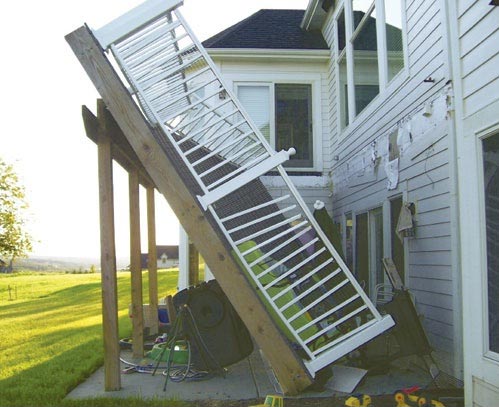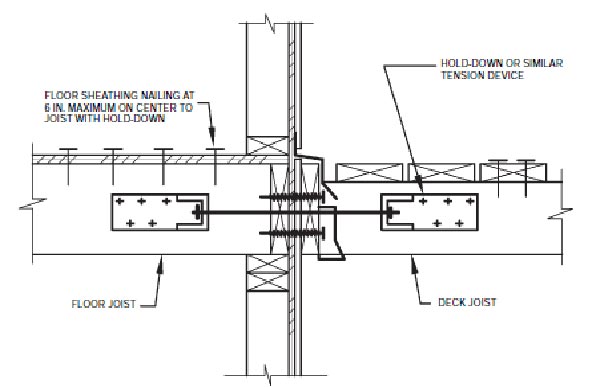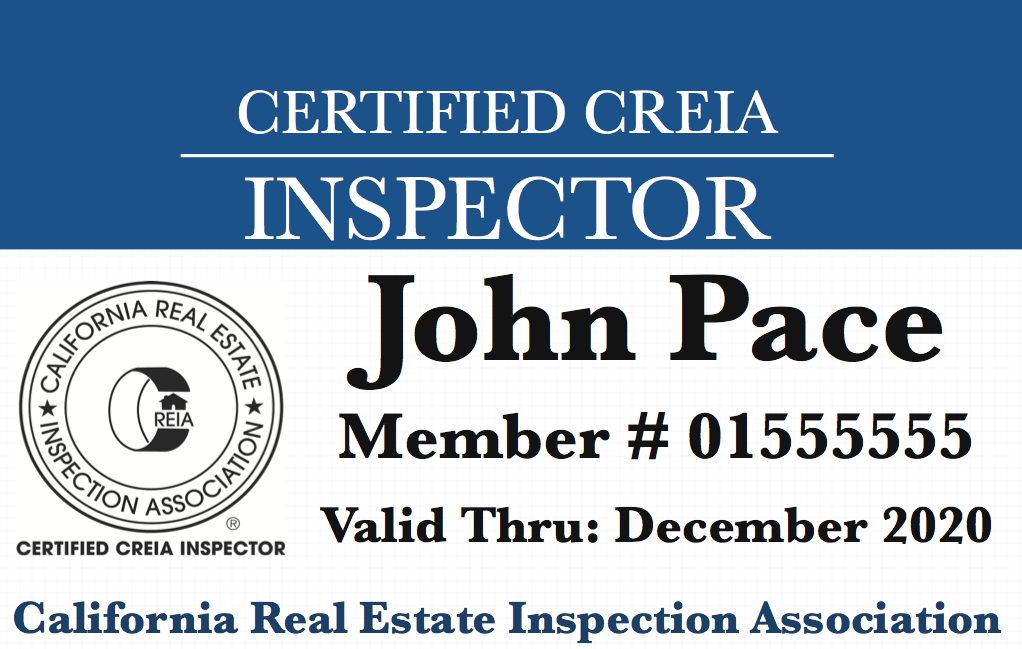Inspecting Wood Decks & BalconiesTECHNICAL ARTICLE
Inspecting Wood Decks & Balconies
By Skip Walker
“ Decks cause more injuries and loss of life than any other part of the home structure. ”
– Don Bender, Director, Wood Materials and Engineering Laboratory,
Washington State University  May is national deck safety month, so it seems appropriate to spend some time reviewing these often overlooked beasts. Most experts agree that the average service life of a wood deck is around 10-15 years. Over 40 million wood decks in the US are OVER 20 years old. Many of these older decks were built prior to the codes providing any significant guidance. Safety is one of the primary focal points of a general property inspection. Developing a “best-practices” approach to our inspections of wood decks and balconies is critical in our role as property inspection professionals. Over 75 percent of people that are on a deck when it collapsed will be injured or killed. Unfortunately, the perception is that wood decks are a DIY project for the Memorial Day weekend or something that the gardener or a handyman can do. The reality is that wood decks are failing at an alarming rate. The primary reasons for the failures are poor construction practices, lack of maintenance and age. Between 2000 and 2006, there were at least 30 deaths reported as a direct result of deck failures. Over 75 percent of people that are on a deck when it collapsed will be injured or killed. As we can see, the proper inspection of wood decks is critical. If we assume that an extremely conservative 1 percent of existing decks are in need of repair or replacement that means 40,000 decks. Using a more realistic estimate of 10 percent brings the total number of unsafe decks to 4 million. Overall, Simpson Strong-Tie estimates that at least 20 million decks are in need of some repair or outright replacement. The two most common points of failure on a wood deck are the connection to the dwelling and the guards. The California Building Code (CBC) defines a deck as an exterior floor supported on at least two opposing sides by an adjacent structure, and/or posts, piers or other independent supports. There are two basic types of decks, free-standing and attached. Balconies are supported 100% by the structure with no external support. For the purposes of this discussion, we will focus on attached decks. Most decks are built from wood. Current standards do not allow the use of redwood for structural members. Much of the redwood seen today is sapwood and not more dense old growth redwood. This is why we see preservatively treated (PT) lumber being used. Composite/plastic materials are becoming increasingly popular for deck surfaces and railings. Composite materials have there own set of issues and – as with any engineered product – they must be installed in accordance with the manufacturers installation instructions. We may see engineered wood products, such as GluLam-type engineered wood beams used as well. Any engineered wood products exposed to weather must be specifically listed for exterior use. The CBC 2007 says: 1604.8.3 Decks. Where supported by attachment to an exterior wall, decks shall be positively anchored to the primary structure and designed for both vertical and lateral loads as applicable. Such attachment shall not be accomplished by the use of toenails or nails subject to withdrawal.* Where positive connection to the primary building structure cannot be verified during inspection, decks shall be self-supporting. For decks with cantilevered framing members, connections to exterior walls or other framing members shall be designed and constructed to resist uplift resulting from the full live load specified in Table 1607.1 acting on the cantilevered portion of the deck. *The bold/underline added for emphasis only. In CBC Table 1607.1, cantilevered decks are required to be designed to the same live/dead loads as the occupancy type served. DECK CONNECTION: The point of connection to the dwelling is probably the most important area of the deck. Older installations may rely on toe-nails, etc. to secure the deck to the dwelling. These older installations are subject to withdrawal and are inherently unsafe. Current best practices recommend a PT ledger board that is attached using through-bolts with washers. The bolt spacing depends on load. The CBC provides no specific guidance on the issue. The IRC includes a ledger connection table. While the IRC will not be adopted in California until the 2010 CBC year, the table does provide us with some useful prescriptive guidelines. In general, we should see staggered bolts every 10”-36”. The use of nails, wood screws, and even some lag bolts and threaded rod to connect a ledger board to the dwelling would generally not be considered acceptable. Most of the lag bolts and threaded rod found on store shelves are not categorized or tested. There are some new deck ledger connection brackets that are engineered for the loads imposed as well. Simpson has a line of screws that are designed for use at the ledger connection. There are other specialty fasteners as well. The CBC 2007 requires that the ledger/deck be “positively anchored.” All fasteners should be hot-dipped galvanized, stainless steel or a fastener specifically designed for PT lumber contact. The National Design Standard (NDS) includes connector strength capacity tables for various connector types and materials. The ledger connection must be properly flashed.
When the IRC 2009 is incorporated into the CBC 2010, there may be some additional language added for deck connections. The IRC 2009 includes previsions for adding a minimum of two tension devices (such as Simpson-type HD's) at the connection point. This is a prescriptive method for adding strength without requiring engineering.
IRC 2009 FIGURE 502.2.2.3 DECK ATTACHMENT FOR LATERAL LOADS
FRAMING ISSUES: In our role as general property inspectors, we are not performing an engineering analysis of the deck. Current standards treat deck installations essentially the same as dwelling floors. The CBC defines a deck as an “exterior floor.” The code writers finally recognized what we see all the time – today's deck is tomorrows sun room and next years family room. Consequently, the framing and load requirements are the same for decks and floors. The critical difference is that the family room floor isn't exposed to the elements 24/7 like the framing for a deck. This means that the deck and support system must be designed to deal with the potential live and dead loads imposed plus weather exposure. All fasteners, structural metal brackets must be appropriate for the stresses imposed and the materials. As with the ledger connection, the fasteners and structural metal brackets should be hot-dipped galvanized, stainless steel or a fastener designed for PT lumber contact such as Simpson Z-Max®. For Simpson products, any metal components in contact with PT lumber should have a part number that ends in either HDG, SS or Z. If a Simpson connector or bracket is in contact with PT lumber does not end in one of these codes, then it is a standard electro-plated part and is improper. Until recently, screws were not approved for most Simpson structural metal connectors. Simpson has recently introduced the Strong-Screw® SD Series that is tested for use in structural applications. In general, any type of standard wood screws, drywall screws, etc. found in structural metal connectors are improper and should be reported.
WOOD DETERIORATION: While the typical property inspector is not licensed to perform a structural pest control inspection, wood deterioration due to decay or insects is a major factor in deck failure. Indications of damage should be noted and referred to the WDO/Structural Pest Control inspector. Decay will be most prevalent in areas that are damp for prolonged periods. Any areas where the design traps or ponds water should be considered suspect and carefully evaluated. PRESERVATIVELY TREATED WOOD: The manufacturers installation instructions for preservatively treated (PT) lumber have required hot-dipped galvanized fasteners for a number of years. In practice, those requirements were largely ignored. Starting circa-2002/2003, the EPA required manufacturers to discontinue the use of arsenic-based PT lumber chemical treatments. This shift has had significant unintended consequences. The current generation of preservatively treated lumber uses either copper-based or borate-based chemical treatments. The borate-based products are water-soluble and will wash out of the wood over time. Borate-based PT wood must not be exposed to weather. Any borate-based PT lumber used in an exterior installation must be reported. Borate products are significantly less corrosive than copper-based materials and you may see it in relatively protected areas, such as mudsills, etc. The copper-based products constitute much of the preservatively treated lumber used today. Copper-based preservatively wood is highly corrosive. Where preservatively treated lumber is used, it is critical that appropriate fasteners must be used. On a typical attached wood deck pr balconies, the most common areas of failure are the connection to the dwelling and the guards. On an attached deck, the point of highest stress are generally at the connection between the wood framing and the concrete piers/foundation and the connection to the dwelling. Imagine the impact on the deck if the framing connections are nailed into a newer PT material using improper fasteners. In a short while, corrosion will compromise these critical connections. In a fairly short time, we will have a deck that is essentially not secured to the dwelling or support system. There are some indications that even hot-dipped galvanized may provide insufficient corrosion protection with the copper-based products – especially in coastal areas or naturally damp environments. Current PT and connector industry recommendations require stainless steel fasteners and structural metal connectors if the installation is within 300 feet of the ocean. The fastener type should match the connector type as well or a dielectric effect may cause corrosion; i.e. stainless fasteners should not be used with hot-dipped galvanized connectors, etc. When PT lumber is field cut, the exposed grain/cut must be field protected with an appropriate material such as copper naphthenate – i.e. Copper Green, etc. SYTHETIC DECKING MATERIALS: When you think of synthetic deck materials, composite products such as TREX® come to mind. These composites are plastic/wood mixtures that are extruded to form deck boards, guards, railings, guard posts, balusters, etc. There are other materials that are all plastic as well. These are often made from PVC materials. Installation is critical to the proper performance of these materials. These are engineered products, as such, they must be installed in accordance with the manufacturers installation instructions. These materials have a fairly high thermal expansion/contraction coefficient, Composites will expand and contract significantly, particularly along the length of the board. End joint gapping requirements can range from 1/8” to as much as 1/2” depending on material and site environmental conditions. Proper end joint gapping is critical. Some materials, specially older versions, may require 12” O.C. spacing for joists. The original composite materials were susceptible to heat and would burn relatively easily. Barbequing, especially on older composite decks, is a bad idea. In a fire, some materials will drop globs of burning plastic. Starting roughly in 2007-2008, composite materials were required to meet more strict fire rating standards as a way to overcome these issues. Several brands of composite material have been subject to a CPSC recall and are currently subject to class-action litigation for premature deterioration, splitting, etc. These materials were manufactured by Louisiana-Pacific and sold under the brand names of LP WeatherBest®, ABTCo., and Veranda®. Home Depot carried the material under the Veranda® brand. FASTENER'S: The use of most screws on Simpson structural metal connectors is improper. Simpson very recently introduced the Strong-Screw® SD series for use in their connectors. In general, screws on older installations are almost always going to be improper. Many nails and bolts do not conform to ASTM/ASME standards. Often, standard power driven nails labeled as 16D may in fact have the load rating of a 10D. The use of undersized nails can significantly degrade the load rating of that metal connector. Most of us are not qualified to perform a structural evaluation. However, care should be taken to make appropriate disclaimers in this regard. SUGGESTED BEST-PRACTICES INSPECTION PROCESS: The following are a suggested overview of the inspection of wood decks and balconies: Guards, railing posts, in-fill: The height, methods of attachment and strength should be inspected. The CBC 2007 requires guards to be a minimum of 42” high with baluster spacing such that a 4” sphere will not pass through the opening. The guards should be able to withstand a 200 lbs concentrated load applied at any point on the railing (CBC 1607A.7.2). Since the guard post acts like a lever, this translates to 1,500-2,500 lbs. (or more) of force applied to the connections at the base of the guard - depending on actual height, post spacing and the number of connectors. In the real world, very few guards are actually constructed to be able to meet this requirement. The in-fill areas should be able to withstand 50 lbs. per square foot of pressure (CBC 1607A.7.1). Guard connections often provide trapping areas as well. Wood and Framing Conditions: Decking should be inspected for deterioration. All trapping areas should be inspected for damage. If the deck is painted, a disclaimer regarding concealed damage is advisable. Wood decking should be inspected for cracking, splitting, nail pull-out, etc. Proper gapping on the decking should be provided to allow for drainage and normal expansion/contraction of the material. Fastener's and metal connectors should be inspected for corrosion, type, etc. Missing fasteners should be noted as well. As noted above, for structural metal connectors, all round/obround holes should have a nail/approved screw installed. Joist and Beam Conditions: All wood framing components should be inspected for deterioration. Any trapping areas should be inspected for damage. If the deck is painted, a disclaimer regarding concealed damage is advisable. Wood members should be inspected for cracking, splitting, etc. Cracks or checks longer than the material depth should be noted as they may reduce load capacity and provide a concealed trapping area. Fastener's and metal connectors should be inspected for corrosion, type, etc. Missing fasteners should be noted as well. As noted above, with structural metal connectors, all round/obround holes should have a nail/approved screw installed. Posts and Footings: The wood posts and cross bracing components should be inspected for deterioration. Any trapping areas should be inspected for damage. The use of preformed piers, like those seen at the lumber yard and big box boys, is a common practice and invariably improper. The CBC footing requirements for a deck are the same as for a foundation. As a very rough rule of thumb, we should see cross-bracing installed when decks are over 8 feet off grade. The cross-bracing should be through bolted, not nailed. Posts should not be spliced on taller installations. When we see 4x4 posts on taller or larger deck installations, they are probably undersized. When in doubt, if it looks wrong, it probably is and should be deferred. If the framing is painted, a disclaimer regarding concealed damage is advisable. Wood members should be inspected for cracking, splitting, etc. Cracks or checks longer than the material depth should be noted as they may reduce load capacity and provide a concealed trapping area. Fastener's and metal connectors should be inspected for corrosion, type, etc. Missing fasteners should be noted as well. As noted above, with structural metal connectors, all round/obround holes should have a nail/approved screw installed. FURTHER INFORMATION: There are a number of resources to draw upon for further information. The North American Deck and Railing Association (NADRA) is an organization comprised of deck contractors and material/component manufacturers. NADRA promotes best practices for deck construction and encourages deck safety inspections. They publish a Consumer Guide to Deck Safety checks. This guide is available online as a free PDF download. The NADRA site has a number of useful documents. Most are geared towards the consumer. One of my personal favorites is the “Manual for the Inspection of Residential Wood Decks and Balconies” by Dr. Frank Woeste, Dr. Joseph Loferski and Cheryl Anderson. This is available through ICC and the Forest Products Society. Dr. Frank Woeste and Dr. Joseph Loferski have also written an article on guard design and testing (JLC February 2005) that is available in the Journal of Light Construction online archive. The American Wood Council/American Forest & Paper Association also publish the Prescriptive Deck Construction Standards Guide – 2009 IRC Version. This is available free online. AWC also publishes a number of other documents, such as the National Design Specification (NDS). NDS is a standard that deals with wood and connector strength values and is incorporated into all model codes. The NDS is not free. Simpson Strong-Tie publishes a wealth of information on deck safety and construction. This is available online at www.strong-tie.com. Simpson also has several free classes on deck construction and Simpson products for building officials and contractors. Both of these classes provide very valuable information. Under a new agreement with Simpson, these classes can also allow you to earn CREIA CEC's at no charge. About the author: Skip Walker lives in the SF Bay Area and has performed well over 2,500 paid inspections since becoming a CREIA member in 2003. Skip is both a CREIA Master Inspector and an ASHI Certified Inspector. Skip is an ICC Certified Residential Combination Building Inspector and a F.I.R.E. Certified Inspector. Skip is the past education chair for the Silicon Valley ASHI/CREIA Chapter. He is also CREIA’s Region Three Director and holds a California Real Estate Appraisal Trainee License. Skip may be reached at [email protected]. |




